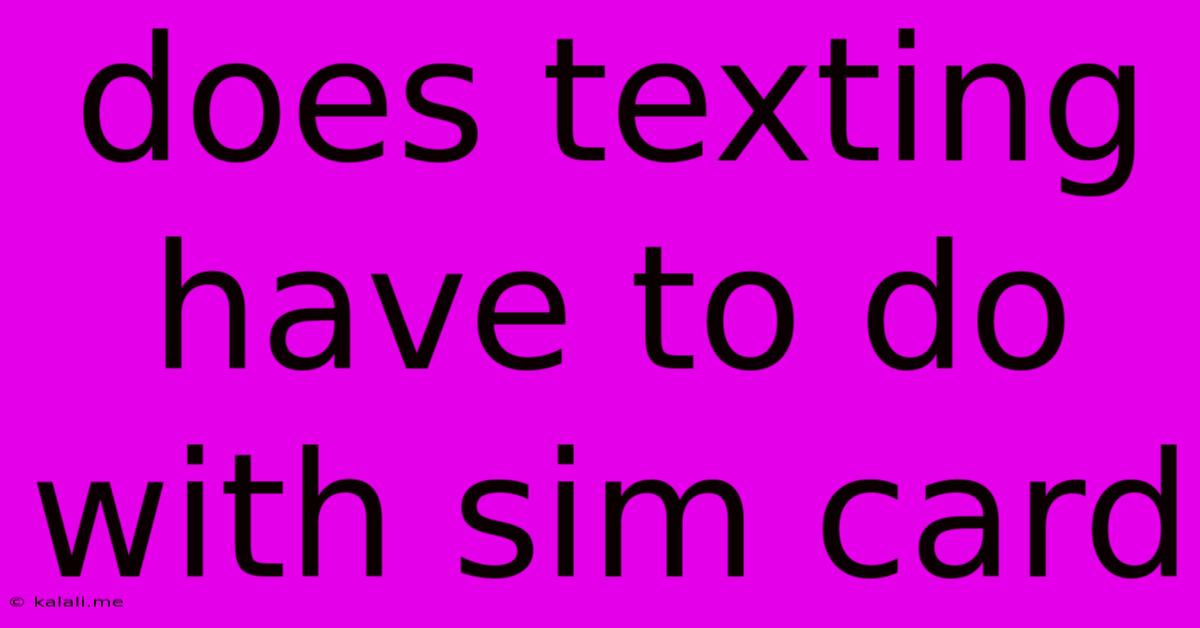Does Texting Have To Do With Sim Card
Kalali
Jun 08, 2025 · 3 min read

Table of Contents
Does Texting Have to Do With a SIM Card? The Essential Link Explained
Texting, or sending Short Message Service (SMS) messages, is a fundamental feature of modern mobile phones. But does this ubiquitous activity actually rely on the small chip nestled within your phone – the SIM card? The short answer is: yes, absolutely. This article will delve into the crucial role a SIM card plays in enabling you to send and receive text messages.
Understanding the relationship between texting and your SIM card is crucial for troubleshooting connectivity issues and grasping the basics of mobile phone technology. This guide will explain the process simply and clearly.
What is a SIM Card?
A Subscriber Identity Module (SIM) card is a small, removable chip that stores subscriber-specific information. This information is essential for connecting your phone to your mobile carrier's network. Crucially, it contains your unique phone number, which is the cornerstone of text messaging. Without a SIM card with an active subscription, you won't be able to send or receive texts. Think of it as your digital identification card on the mobile network.
How the SIM Card Enables Texting
The process is more intricate than simply inserting the card. Here's a simplified breakdown:
-
Network Identification: When your phone is switched on, it uses the SIM card to identify itself to the nearest mobile network tower. The SIM card's information helps the network authenticate your device and assign you a temporary channel for communication.
-
Message Formatting and Transmission: When you compose a text message, your phone uses the information on the SIM card to include your phone number as the sender ID. The message itself is then formatted into a data packet that is ready for transmission.
-
Routing through the Network: Your message is sent through a series of mobile network towers and switches, guided by the network information linked to your SIM card. The network uses the recipient's phone number (also managed via SIM cards) to find the correct destination.
-
Message Delivery: Once the message reaches the recipient's mobile network, it is delivered to their phone. Again, their SIM card plays a crucial role in receiving and displaying the message correctly.
What Happens Without a SIM Card?
Without a properly installed and active SIM card, your phone will likely be unable to send or receive text messages, make calls, or use mobile data. You might see an "Emergency Calls Only" or similar message. The phone can still perform some functions like using Wi-Fi for internet access (for certain apps) but core cellular services, including texting, are unavailable.
Troubleshooting Texting Issues
If you're experiencing problems texting, checking your SIM card is a vital first step in troubleshooting. Ensure it is correctly inserted and that your mobile subscription is active with sufficient credit or data. Contact your mobile carrier if problems persist.
Different SIM Card Types and Texting
While the fundamental role remains the same, different SIM card types (e.g., Nano SIM, Micro SIM) don't alter the core functionality of texting. The size difference simply affects the physical compatibility with your device.
In conclusion, the SIM card is indispensable for texting. It acts as the key that unlocks your phone's ability to communicate via SMS with the wider mobile network. Without it, the world of quick and convenient text messaging is simply unavailable.
Latest Posts
Latest Posts
-
Why White Paint On Tree Trunks
Jun 08, 2025
-
How To Change Frame Rate Gif Photoshop
Jun 08, 2025
-
How To Call China From America
Jun 08, 2025
-
What Is Partial Based Spectral Centroid
Jun 08, 2025
-
I Am Not Satisfied With Your Reasons Rejection Job Offer
Jun 08, 2025
Related Post
Thank you for visiting our website which covers about Does Texting Have To Do With Sim Card . We hope the information provided has been useful to you. Feel free to contact us if you have any questions or need further assistance. See you next time and don't miss to bookmark.